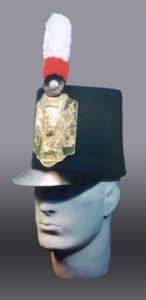Part 1 of the History of the British Infantry Shako
Since the middle of the seventeenth century, soldiers had been wearing broad brimmed felt hats. The decline of armour as a result of the increased use of firearms had moved headwear into this more practical direction. For the next one hundred and fifty years the broad brimmed felt hat stayed in use. Its sides were turned up in various ways, but it retained its essential design.
At the end of the eighteenth century there was a quest for a new look for Britain’s soldiers. Coats that had been lapeled were suddenly single breasted and shortened. Hat designs inspired by the Hungarian csákó — in English, pronounced shako — influenced other European nation’s armies and resulted in a cylindrical cap with a visor to act as a sun shade being adopted by Great Britain.
The first model of this cap was introduced into the infantry in 1800. It was made of lacquered linen. On its front it bore a large brass plate almost the entire height of the cap with the Royal motto in a garter and George the Third cypher in the centre, surmounted by a crown. Under the garter was a lion. Flanking the design was a trophy of arms. Above the plate was the Hanoverian cockade in tooled black leather with a regimental button in the centre. Arising out of a leather socket was a worsted wool tuft about six inches high. The tuft was coloured for the company. Battalion companies had a tuft that was red on the bottom third and white above. Grenadiers, considered an elite company, when not wearing the bearskin wore the same shako with a white tuft (see Figure 1). Light company men wore a tuft of dark green.
Figure 2 shows the shako as it was worn by the eight Battalion companies in every line regiment. The design of the plate was subject to regimental variations, and many exist. Ancient badges, honours and numbers were proudly displayed on the plate. Figure 3 is an example of the plate used by the 1st Regiment of Foot (Royal Scots). It replaces the Royal cypher with its thistle badge and beneath the lion the motto “Royal”.
The cap was also in use with Light Infantry regiments, the 95th Rifle regiment and the Royal Artillery. The Artillery was not part of the army and was administered by the Board of Ordinance. In matters of dress, however, they usually followed the style of the Army, although not necessarily at the same instant. Figure 4 below shows the plate worn on the Royal Artillery version of the hat. The artillery also wore a white worsted tuft, the same as the grenadier companies.

Figure 3. Royal Scots plate. Photo by Seaghan Hancocks 
Figure 4. Royal Artillery plate. Photo by Peter Twist
Rifle and Light Infantry regiments and those dressed like them used a bugle badge on the front of the plate instead of the larger Line Infantry design. Although the Line replaced the cap with a new model in 1812, The Lights and Rifles stayed with the older style. The Rifles also added dark green cap lines to the cap as well as wearing the dark green tuft like the Lights. Below are two images of Glengarry Light infantry caps. Figure 5 is an officer’s and Figure 6 an OR’s (Other Ranks).

Figure 5. Glengarry Light Infantry Officer shako. Picture by Peter Twist 
Figure 6. Glengarry Light Infantry private. Picture by Peter Twist
The stovepipe cap ultimately was replaced because the enemy had much fancier and more attractive headwear. Fashion more than anything dictated it’s replacement which will be the topic of the next article.



